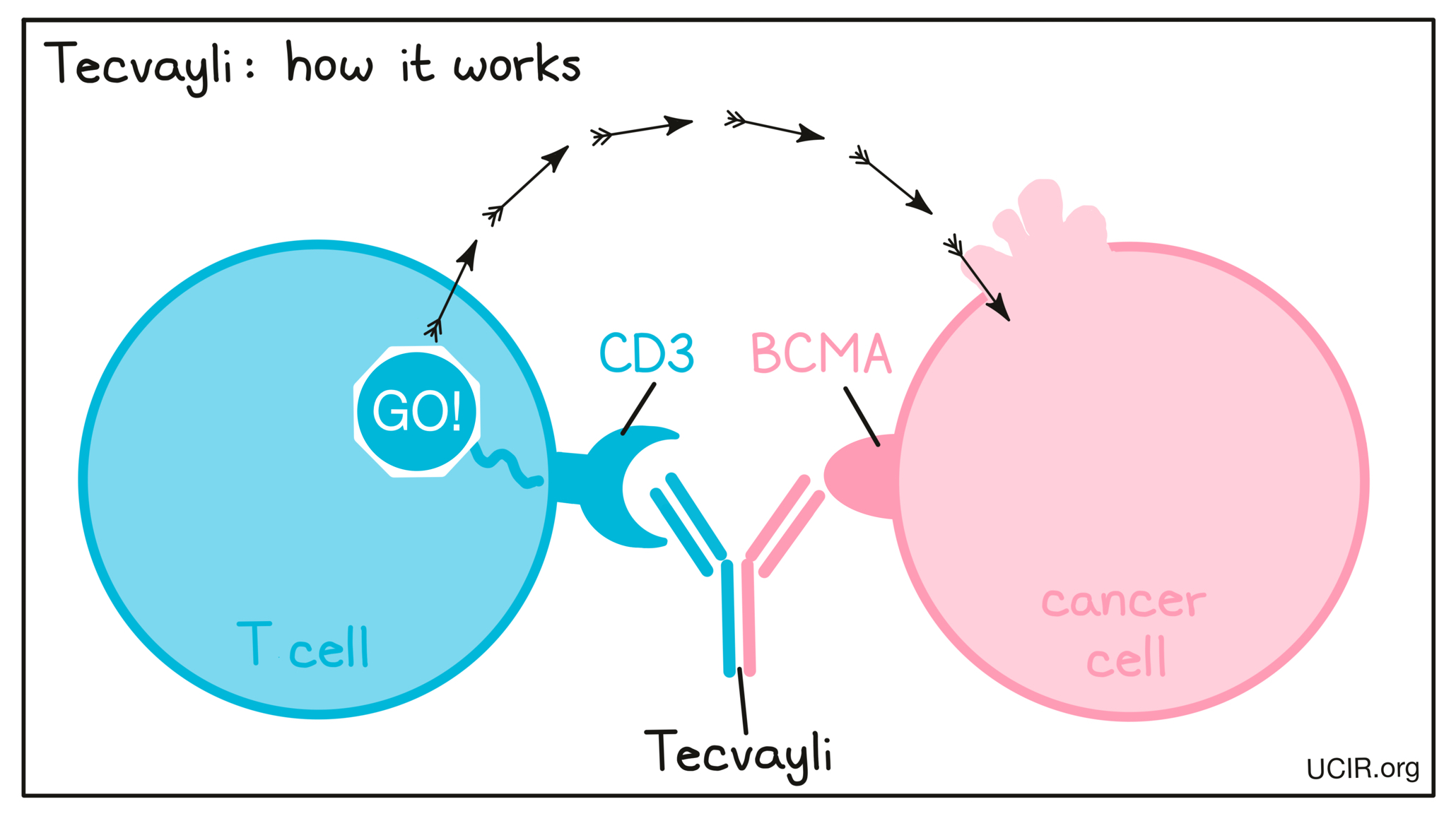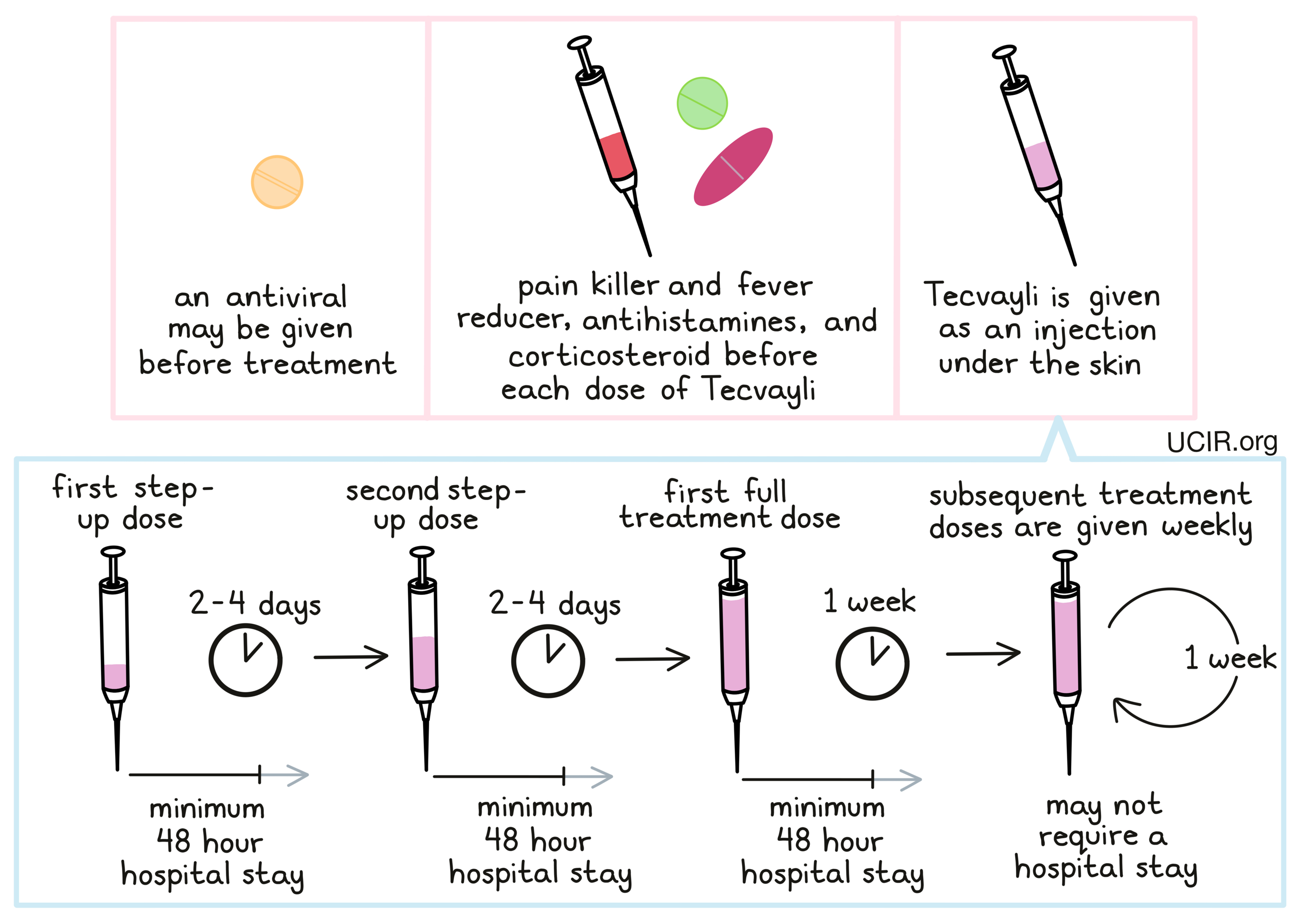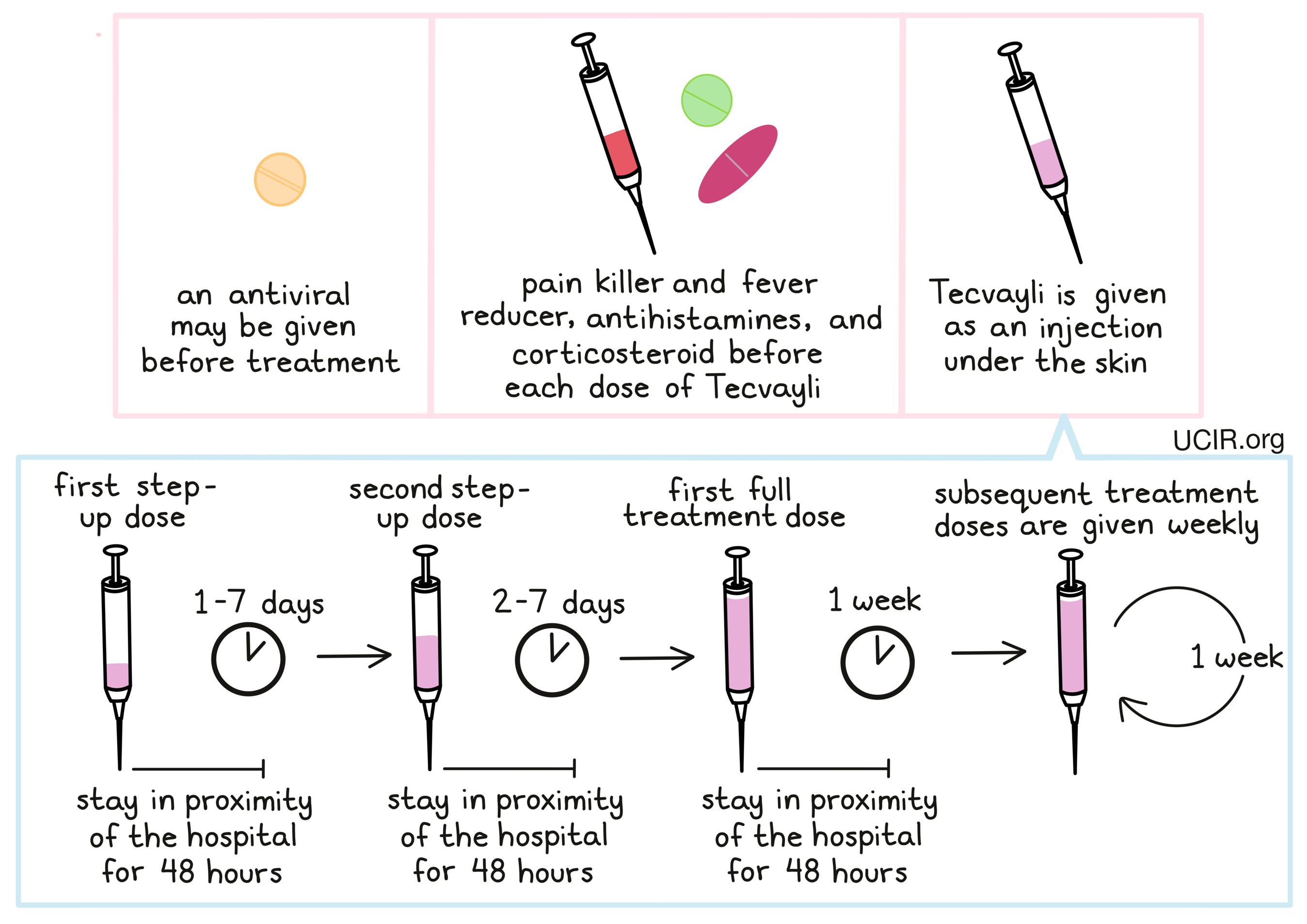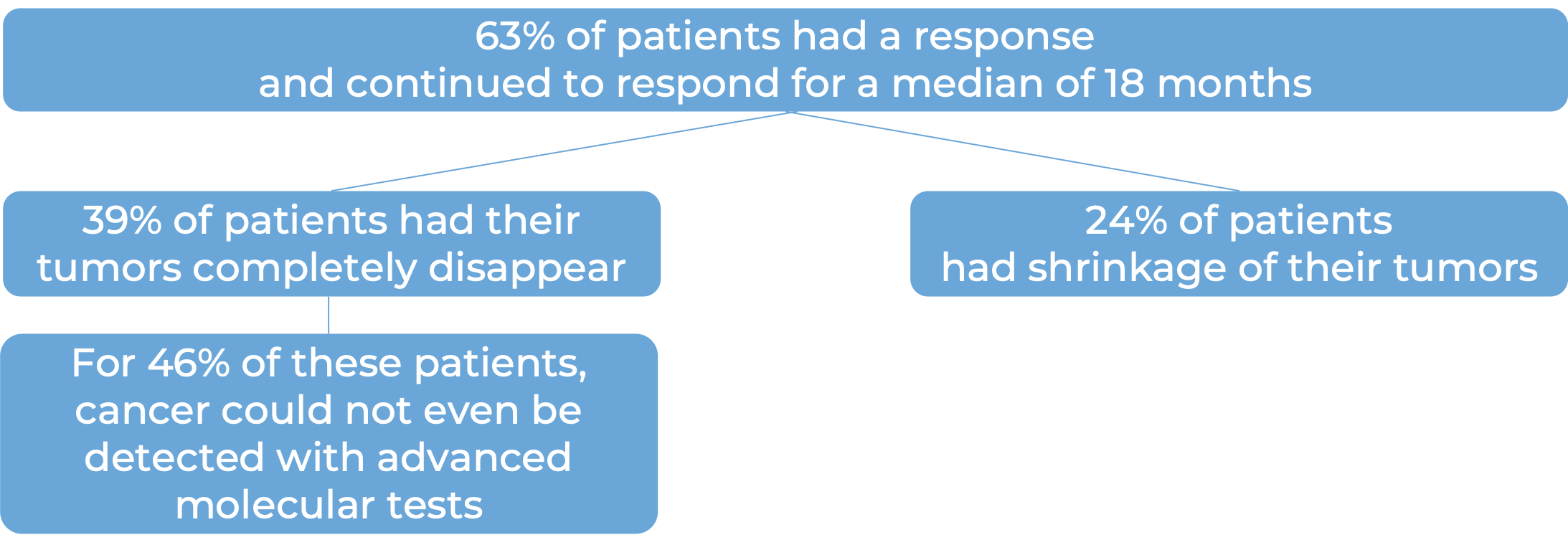How is this drug name pronounced?
Teclistamab: tek-LIS-tuh-mab
Tecvayli: tek-VAY-lee
What cancer(s) does this drug treat?
Multiple Myeloma
Tecvayli is approved for:
- Patients with multiple myeloma who have received at least four prior treatments for their disease, including an anti-CD38 antibody (e.g., daratumumab (Darzalex) or isatuximab-irfc (Sarclisa)), a proteasome inhibitor, and an immunomodulatory agent, but whose cancer either did not respond to treatment or has since come back.
Limitations of use
Tecvayli REMS program: Due to the risk of potentially serious side effects, Tecvayli is currently only available through a Risk Evaluation and Mitigation Strategy (REMS) program. Hospitals or clinics that dispense Tecvayli require certification for the program, ensuring proper monitoring and management of side effects associated with the drug.
Age: The safety and efficacy of Tecvayli in patients under 18 years of age have not been established.
Pregnancy/Breastfeeding: Tecvayli is not recommended for use during pregnancy due to potential for harm to the fetus. Patients are advised to use contraception during treatment with Tecvayli and for at least 5 months after the last dose of Tecvayli. The risks associated with Tecvayli during breastfeeding are not known and cannot be ruled out. Due to the potential for adverse reactions in the breastfed child, patients are advised not to breastfeed during treatment with Tecvayli.
What type of immunotherapy is this?
How does this drug work?
Targets:
- B cell maturation antigen (BCMA) on B cells
- CD3 receptor on T cells
Tecvayli is a “bispecific antibody”. Antibodies are molecules which can bind to a particular target molecule. Bispecific antibodies are artificially made in the laboratory and can bind to two different targets at the same time. Tecvayli binds to:
- a molecule called B cell maturation antigen (BCMA) on the surface of multiple myeloma cells and some healthy B cells. BCMA is present in much higher quantities on the surface of cancer cells than normal healthy cells.
- a molecule called CD3 on the surface of T cells – the primary immune cells involved in killing cancer cells. CD3 is part of the T cell receptor, which is critical to the function of the T cell and is involved in stimulating the T cell to become active.
Because Tecvayli can bind to one molecule on myeloma cells and one on T cells at the same time, it acts as a bridge and keeps the T cell in close contact with the cancer cell. By binding CD3 on the T cell, Tecvayli also stimulates the T cell to become activated and kill the cell it is bound to. Bispecific antibodies that direct T cells to kill cancer cells by binding to both cells at the same time are known as bispecific T cell engagers (BiTEs).

How is the drug given to the patient?
Before starting treatment with Tecvayli, patients may receive antiviral medication to prevent herpes zoster (shingles) reactivation during treatment.
About 1 to 3 hours prior to receiving first doses of Tecvayli, patients receive several medications to help reduce the risk of cytokine release syndrome:
- A corticosteroid (dexamethasone or methylprednisolone)
- An antihistamine (diphenhydramine)
- A painkiller and fever reducer (acetaminophen)
Tecvayli is administered in the form of an injection under the skin (subcutaneous [s.c.] injection) usually in the stomach area or thigh. The first “step-up dose” is administered on day 1, a second “step-up dose” with a higher amount of Tecvayli is usually given between day 2 and 4 after the first dose, and the first “treatment dose” with a fixed amount of Tecvayli is administered 2 to 4 days after the second step-up dose. Patients should stay in the hospital for at least 48 hours after each step-up dose and after the first treatment dose. Subsequent treatment doses are administered once a week and may not require a hospital stay.
The step-up dosing schedule and hospitalization is also recommended when restarting treatment after any interruptions.
Before and periodically during the treatment blood tests will be performed to monitor for side effects.

What are the observed clinical results?
It is important to keep in mind that each patient’s outcome is individual and may be different from the results found in the clinical studies. In addition, immunotherapy can sometimes take several months to yield an observable treatment response.
Multiple myeloma
In a clinical study, 110 patients with multiple myeloma who had received at least four prior treatments for their disease, but whose cancer either did not respond to treatment or had since come back, were treated with Tecvayli.

It has been estimated that 67% of patients who responded to treatment continued to respond for 9 months.
What are the potential side effects?
Tecvayli targets the B cell maturation antigen (BCMA), which, while present on myeloma cells, is also present on some normal B cells. As a result, Tecvayli can kill normal B cells, increasing the risk of serious infections. Other common side effects of Tecvayli include fever, cytokine release syndrome, pain in muscle and bones, reactions at the Tecvayli injection site, fatigue, nausea, headache, diarrhea, low white blood cell count, low red blood cell count, and low platelet count. Some side effects, such as cytokine release syndrome, neurological toxicities, liver problems, or infections, can become serious or life-threatening. Patients and caregivers receive careful instructions to monitor for signs and symptoms of side effects. These conditions are managed by the healthcare provider.
Cytokine release syndrome (CRS)
CRS is caused by a widespread release of molecules called cytokines, which can cause inflammation and can affect the function of various organs. Cytokines may be released by the T cells to which Tecvayli binds, or by other immune cells in the patient’s body. Signs and symptoms of CRS include fever, headache, nausea, low blood pressure, and weakness. CRS typically occurs 2 days after the start of Tecvayli treatment. A healthcare provider should be immediately notified if symptoms occur.
Neurological toxicities
Some of the cytokines released during CRS can result in disruption of the blood–brain barrier, leading to the development of neurological toxicities. Symptoms of neurological toxicities include headache, tremors, seizures, loss of consciousness, confusion, difficulty with speech, and loss of balance. Neurological toxicities typically occur within 2 to 8 days after the most recent dose of Tecvayli.
For a more complete list of possible side effects, see the full prescribing information.
Manufacturer
Janssen Biotech
Approval
FDA and EMA
Links to drug websites
Last updated: October 27, 2022
How is this drug name pronounced?
Teclistamab: tek-LIS-tuh-mab
Tecvayli: tek-VAY-lee
What cancer(s) does this drug treat?
Multiple Myeloma
Tecvayli is approved for:
- Patients with multiple myeloma who have received at least three prior treatments for their disease, including an anti-CD38 antibody (e.g., daratumumab (Darzalex) or isatuximab-irfc (Sarclisa)), a proteasome inhibitor, and an immunomodulatory agent, but whose cancer either did not respond to treatment or has since come back.
Limitations of use
Limitations: Tecvayli should only be administered by adequately trained healthcare professionals who can ensure proper monitoring and management of side effects associated with the drug.
Age: The safety and efficacy of Tecvayli in patients under 18 years of age have not been established.
Pregnancy/Breastfeeding: Tecvayli is not recommended for use during pregnancy due to potential for harm to the fetus. Patients who may become pregnant are advised to use contraception during treatment with Tecvayli and for at least 5 months after the last dose of Tecvayli, while patients whose partners may become pregnant should use contraception for at least 3 months after the last dose of Tecvayli. The risks associated with Tecvayli during breastfeeding are not known and cannot be ruled out. Due to the potential for adverse reactions in the breastfed child, patients are advised not to breastfeed during treatment with Tecvayli and for at least 5 months after the last dose of Tecvayli.
Effects on the ability to drive and use machines: Patients are advised to refrain from driving, engaging in potentially dangerous activities, and operating heavy machinery for at least 48 hours after receiving the step-up doses and the first dose of Tecvayli, and in the event of any neurological symptoms.
Infections: Tecvayli should not be administered in patients with an active infection.
Vaccinations: Vaccination with live virus vaccines (e.g., chickenpox, measles/mumps/rubella [MMR]) is not recommended for at least 4 weeks prior to the start of Tecvayli treatment, during treatment, and at least 4 weeks after treatment with Tecvayli.
Interactions with other drugs: Dose adjustments may become necessary for patients treated with CYP450 substrates (e.g., warfarin, cyclosporin, theophylline) at the start of treatment with Tecvayli.
What type of immunotherapy is this?
How does this drug work?
Targets:
- B cell maturation antigen (BCMA) on B cells
- CD3 receptor on T cells
Tecvayli is a “bispecific antibody”. Antibodies are molecules which can bind to a particular target molecule. Bispecific antibodies are artificially made in the laboratory and can bind to two different targets at the same time. Tecvayli binds to:
- a molecule called B cell maturation antigen (BCMA) on the surface of multiple myeloma cells and some healthy B cells. BCMA is present in much higher quantities on the surface of cancer cells than normal healthy cells.
- a molecule called CD3 on the surface of T cells – the primary immune cells involved in killing cancer cells. CD3 is part of the T cell receptor, which is critical to the function of the T cell and is involved in stimulating the T cell to become active.
Because Tecvayli can bind to one molecule on myeloma cells and one on T cells at the same time, it acts as a bridge and keeps the T cell in close contact with the cancer cell. By binding CD3 on the T cell, Tecvayli also stimulates the T cell to become activated and kill the cell it is bound to. Bispecific antibodies that direct T cells to kill cancer cells by binding to both cells at the same time are known as bispecific T cell engagers (BiTEs).

How is the drug given to the patient?
Before starting treatment with Tecvayli, patients may receive antiviral medication to prevent herpes zoster (shingles) reactivation during treatment.
About 1 to 3 hours prior to receiving first doses of Tecvayli, patients receive several medications to help reduce the risk of cytokine release syndrome:
- A corticosteroid (dexamethasone or methylprednisolone)
- An antihistamine (diphenhydramine)
- A painkiller and fever reducer (acetaminophen/paracetamol)
Tecvayli is administered in the form of an injection under the skin (subcutaneous [s.c.] injection) usually in the stomach area or thigh. The first “step-up dose” is administered on day 1, a second “step-up dose” with a higher amount of Tecvayli is usually given between day 2 and 7 after the first dose, and the first “treatment dose” with a fixed amount of Tecvayli is administered 2 to 7 days after the second step-up dose. Patients should stay in proximity of the hospital and monitor for signs and symptoms of cytokine release syndrome for at least 48 hours after each step-up dose and after the first treatment dose. Subsequent treatment doses are administered once a week. For patients whose cancer disappears completely for at least 6 months, reducing the dosing frequency to every 2 weeks may be considered.
The step-up dosing schedule is also recommended when restarting treatment after any interruptions.
Before and periodically during the treatment blood tests will be performed to monitor for side effects.

What are the observed clinical results?
It is important to keep in mind that each patient’s outcome is individual and may be different from the results found in the clinical studies. In addition, immunotherapy can sometimes take several months to yield an observable treatment response.
Multiple myeloma
In a clinical study, 165 patients with multiple myeloma who had received at least three prior treatments for their disease, but whose cancer either did not respond to treatment or had since come back, were treated with Tecvayli. At a median follow-up of 14 months:

What are the potential side effects?
Tecvayli targets the B cell maturation antigen (BCMA), which, while present on myeloma cells, is also present on some normal B cells. As a result, Tecvayli can kill normal B cells, increasing the risk of serious infections. Other common side effects of Tecvayli include fever, cytokine release syndrome, pain in muscle and bones, reactions at the Tecvayli injection site, fatigue, nausea, headache, diarrhea, low white blood cell count, low red blood cell count, and low platelet count. Some side effects, such as cytokine release syndrome, neurological toxicities, liver problems, or infections, can become serious or life-threatening. Patients and caregivers receive careful instructions to monitor for signs and symptoms of side effects. These conditions are managed by the healthcare provider.
Cytokine release syndrome (CRS)
CRS is caused by a widespread release of molecules called cytokines, which can cause inflammation and can affect the function of various organs. Cytokines may be released by the T cells to which Tecvayli binds, or by other immune cells in the patient’s body. Signs and symptoms of CRS include fever, headache, nausea, low blood pressure, and weakness. CRS typically occurs 2 days after the start of Tecvayli treatment. A healthcare provider should be immediately notified if symptoms occur.
Neurological toxicities
Some of the cytokines released during CRS can result in disruption of the blood–brain barrier, leading to the development of neurological toxicities, including Immune Effector Cell-Associated Neurotoxicity Syndrome (ICANS). Symptoms of neurological toxicities include headache, tremors, seizures, loss of consciousness, confusion, difficulty with speech, and loss of balance. Neurological toxicities typically occur within 0 to 21 days after the most recent dose of Tecvayli.
For a more complete list of possible side effects, see the full prescribing information.
Manufacturer
Janssen Biotech
Approval
FDA and EMA
Links to drug websites
Other references
Last updated: July 16, 2024







